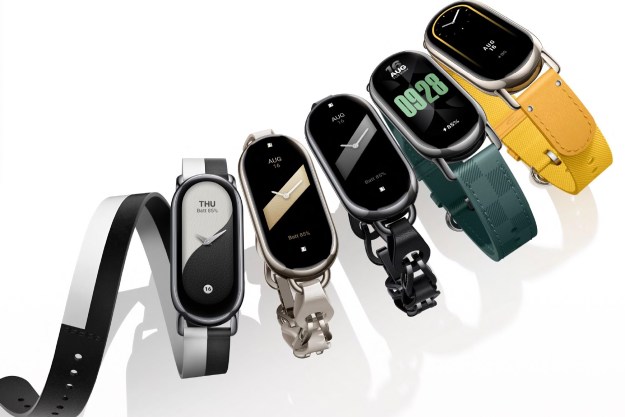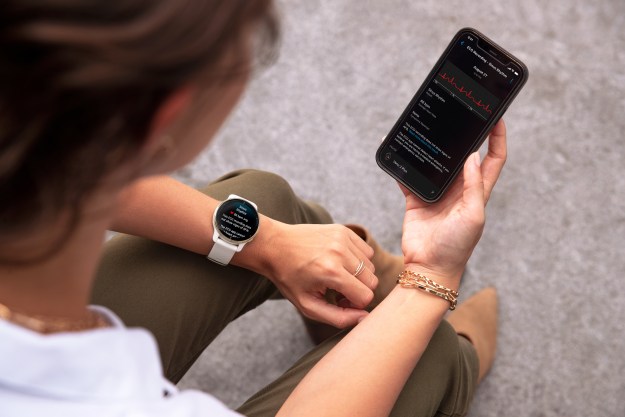Hot on the heels of a victory in court against Jawbone, Fitbit’s adding two more products to its portfolio of fitness-tracking devices — the Charge 2 and the Flex 2.
The company also has a slew of other announcements, such as new gold variants for the Fitbit Alta and Blaze, as well as software features coming to its iOS and Android app. You can read more about them right here.
We’ve had our hands on the Charge 2 for a few days, but Fitbit has only offered a demo unit of the Flex 2 — we’ll offer a full review when we get the final product in September. The Charge 2’s final software is rolling out to test devices today, so while we’re only offering a quick hands on at the moment, expect a full review in the coming weeks. Let’s dive in.
Fitbit Flex 2
The Flex 2, as the name suggests, is the successor to the 2013 Flex and it’s quite the upgrade, both physically and visually. The original Flex’s removable sensor was large and looked like a 9-volt battery. The Flex 2 is now “ultra-slim,” light, and cylindrical. It still retains the same five LEDs on the front, but it offers up a little more information than before.

When it flashes red, the Flex 2 is nudging you to move after being stationary for too long. That’s right, Reminders to Move is no longer a feature limited to the Fitbit Alta. It’s now also available on the Flex 2, Charge 2, and Blaze. The Flex 2 can also flash white, blue, green, and yellow in different combinations, indicating notifications for calls, texts, silent alarms, as well as letting you know when you hit your pre-set goals.
But the real highlight feature of the Flex 2 is that it’s the company’s first “swim-proof” device. You can take it underwater up to 50m, and once you start swimming, your laps and other data will automatically be recorded. That goes for other activities such as biking and running thanks to SmartTrack — a feature Fitbit unveiled last year. It also automatically tracks sleeping, calories burned, distance, and more. The Flex 2 syncs via the Fitbit app on iOS and Android, and the company claims a five-day battery life.
The other main differentiation of the Flex series is that the sensor is removable, allowing you to wear the device in different ways. It’s why Fitbit is offering pendants and bangles that can carry the sensor, though auto sleep tracking and SmartTrack may be disabled when in the pendant. The silver pendant costs $80, and the gold one is priced at $100 — that’s separate from the tracker, which will set you back $100. The bangles come in small and large; the silver costs $90, whereas the gold and rose gold variant is priced at $100.
When you purchase the device, you’ll get a large and small silicone band in four varying colors: lavender, black, magenta, and navy. Our lavender variant was easy to snap on and off, and it looked sleek. The sensor was easy to take out, except not so much out of the bangle — you’ll definitely need nails for that.
Additional colored bands can be purchased for $15. You can pre-order the Flex 2 at Fitbit.com today, and from other online retailers such as Amazon, Best Buy, and Target on Tuesday. The Flex 2 ships in October.
Fitbit Charge 2
The Charge 2 is actually the third fitness tracker in its series. It supersedes the original Charge and Charge HR, the latter of which added a heart rate monitor. The latest addition offers the same PurePulse Heart Rate technology in devices like the Charge HR and Fitbit Surge, as it continuously tracks your heart beat to provide more accurate and helpful data over a period of time.
Design and display
Visually, the Charge 2 has more in common with the Fitbit Alta than its predecessors. It’s a little wider, but otherwise it’s hard to tell the two apart. That’s good, because the Alta and the Charge 2 are some of Fitbit’s more aesthetically-pleasing devices. It’s easy to forget you’re wearing it, and it really can be quite stylish and fun to interact with.
The Charge 2 also has a display four times the size of the Charge and Charge HR, though the elongated screen is actually quite small and is surrounded by massive bezels. Thankfully, the screen is easy to read and blends into the bezels. Unlike the Alta, the Charge 2 has a button on its right side. It’s what’s used to cycle between five different screens on the device.
You can tap on the screen jump to different modes in each respective setting, but that’s the extent of how you can interact with the screen — there’s no swiping here. Double tapping turns the screen on, or you can raise the device and turn it toward you to activate it automatically. The latter feature works most of the time, but we had occasions when the screen stayed blank.
You can only find out that your battery is low via the app, or when Fitbit decides to send you an email.
Similarly, tapping the screen to cycle through modes worked fine 99 percent of the time we tried. There were instanced when we had to try tapping a few times for it to work. One annoyance is the short timer for how long the screen stays on — it lights up for five to six seconds, but we found the need to constantly press the button to turn it back on.
The strap has a neat, ridged pattern, and it feels high-end and well-made. It’s easy to swap out, and there are a variety of color options for the Charge 2 ranging from black, blue, plum, and teal. You can choose a strap that’s small or large, while an XL option is available in black and online only. Fitbit is also offering two special edition models: one with a rose gold frame and a lavender strap, and the other with a gunmetal frame and a black strap.
The most annoying part of the Charge 2 is slipping it on and off — there’s a small nub on the loop of the strap that’s meant to secure the strap in place. Instead, it makes the device all the more difficult to quickly put on or take off. And taking it off feels as though the strap is about to rip off. The whole process is not elegant, and we felt as though the nub doesn’t need to be there.
Software features
The main screen shows the time and date, but you can also tap the screen to glance at various data sets, such as steps taken, beats per minute, distance traveled, calories burned, floors climbed, minutes you were active, and how many steps you took in your hourly Reminders to Move. Press the button on the side to cycle through the following features: the heart-rate monitor, activity mode, the stopwatch, and guided breathing sessions.
The latter is one of two new exercise features debuting on the Charge 2. Guided breathing sessions, or “Relax,” allow you to keep calm by taking 2 or 5 minutes to inhale and exhale. Once you trigger a session, which you do by pressing and holding the button, your heart rate will be tracked, allowing you to receive personalized prompts to take deep breaths.
But the more interesting, and perhaps more important, feature debuting on this tracker is Cardio Fitness Score. It’s similar to a VO2 Max test, which is used to gauge an athlete’s fitness level, though it’s typically done in a lab environment. The athlete runs on a treadmill until he or she can no longer continue.
You don’t need to do that for Fitbit’s test, though you can go on a run if you want slightly more accurate results. For an estimation of your fitness score, all you need to do is wear the Charge 2 for a day, even when you sleep. You’ll be lumped in one of many fitness categories ranging from poor to excellent. The score is then compared to other results based on gender and age. For example, Fitbit will say “your score of 38-42 is Fair for men your age.”
Fitbit doesn’t just offer the data though — tap your score and you’ll be presented a way to increase it. These can be recommendations to start a high intensity workout, a focus on weight loss, and more.
As expected, the Charge 2 can automatically track certain exercises. To manually start, cycle to the Activity mode and tap on the screen to choose from Run, Weights, Treadmill, Workout, Elliptical, Bike, and Interval Workout. When you trigger one of these activities, a timer will start along with more real-time data you can cycle through — including distance, beats per minute, pace, calories burned, and more.
Fitbit claims the battery lasts five days, but on our fourth day of use, the battery seemed close to running out. And that’s with minimal to average use. We’ll have to test the claim to see if it holds up, so expect to see that in our review. A big bummer is the lack of a battery notification on the device — you can only find out that your battery is low via the app, or when Fitbit decides to send you an email.
Warranty and availability
Fitbit offers a limited service warranty for the Charge 2, meaning that the company will repair any defects deemed valid within the first year of purchase. That doesn’t include accidental damage or water damage.
The strap has a neat, ridged pattern, and it feels high-end and well-made.
The Charge 2, like the Flex 2, is available for pre-order now on Fitbit.com, and via other online retailers such as Amazon, Best Buy, and Target on Tuesday. It’ll cost you $150, but the special edition variants costs $180. You can buy classic bands in different colors priced at $30, or go for the more luxurious leather bands for $70. Unlike the Flex 2, the Charge 2 ships in September.
A great value
Through our limited use, we found the Fitbit Charge 2 to be a compelling and a helpful companion. Where smartwatches want to offer you everything at once, Fitbit’s Charge 2 gives you the basic call, text, and calendar notifications, with relatively robust fitness-tracking capabilities. It has been accurate in our tests so far, and its long battery life is certainly refreshing.
Highs
- Beautiful design
- Removable straps
- Long battery life
Lows
- No battery status notifier
- Taps and gesture-based wake can occasionally be finicky
- Strap is difficult to put on and take off
Editors' Recommendations
- Why you shouldn’t buy these 5 Apple Watch Series 9 alternatives
- Does the Google Pixel Watch 2 have wireless charging?
- The future of Fitbit doesn’t look good
- Polar’s newest smartwatch could be a Fitbit and Garmin killer
- The Fitbit Charge 6 is a fitness tracker and smartwatch hybrid





